As promised when we sent our first collection of memories on Bob Rauschenberg last month, the Felsen family has continued to comb the archive of Sidney’s photographs. Today would have been Ellsworth Kelly’s 97th birthday, and with all the unrest in the country, it seems befitting to celebrate an artist who was a champion of justice and equality, and to remember the many good times we had with "EK."
Our story begins with an adaptation from "Letters to Ellsworth" (published 2011 by the Jordan Schnitzer Family Foundation) under the title “A ‘Large Gray Curve’ (and other matters of the heart).” It is updated and reprinted here with the kind permission of Jordan Schnitzer.

It was a warm late-August day in 1977 when I first stepped into Sidney Felsen’s office at Gemini G.E.L. A year out of college and a naïve art-history major with virtually no knowledge of contemporary art, I had never heard of Gemini. Nor printmaking. Although I only later realized it, I had been in the presence of Gemini editions (the Stanford Law School, where I took one class, and the nearby Anderson Collection were populated grandly with Gemini prints), but I had no appreciation for contemporary artists and their printmaking endeavors.
On the wall of Sidney’s office was installed, over his desk, Ellsworth Kelly’s Large Gray Curve. Conceived and completed in 1974, this magnificent, elegant artwork completely escaped my attention. That is until, during the interview, Sidney asked me if I knew anything about contemporary art. I said I had taken one survey class that had touched on it only slightly. He asked, “So, for example, do you know who did this print hanging here?” Like a schoolgirl trying to bluff the professor, I said “Well, I recognize the image but I can’t remember the name of the artist.”
Somehow, I got the job, and eventually I married the boss. And on that August day, I walked through the looking glass.
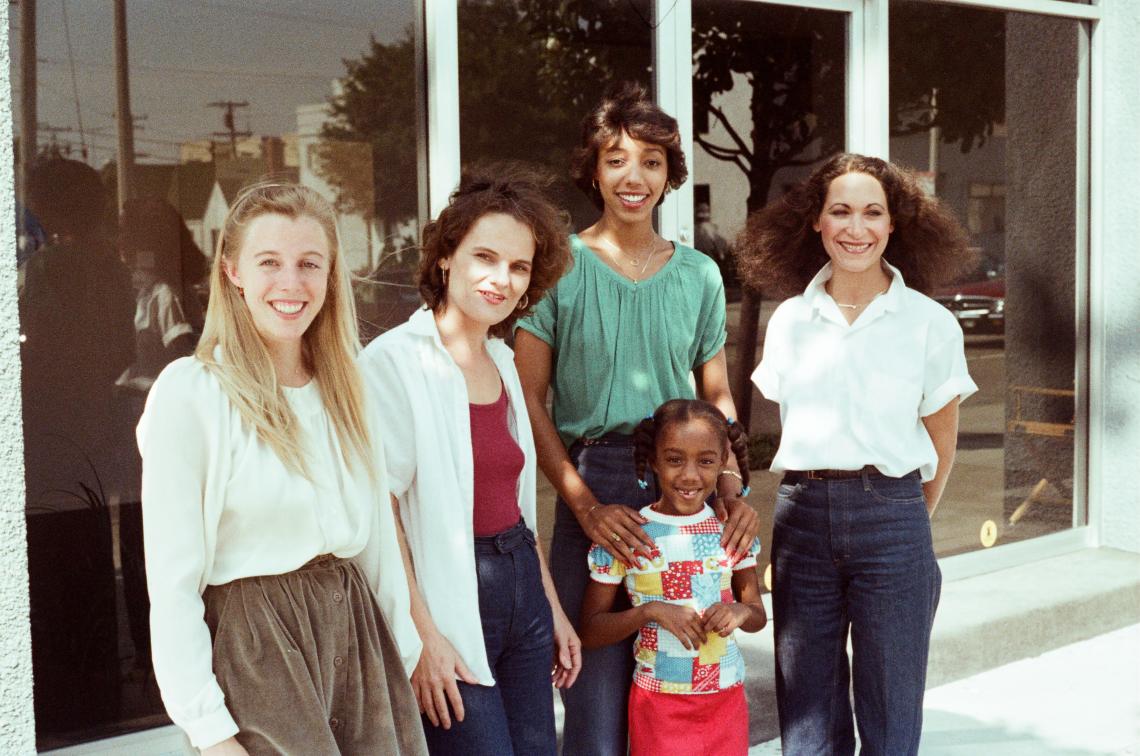 Joni and the Gemini G.E.L. administrative team, September 1977
Joni and the Gemini G.E.L. administrative team, September 1977
Perhaps because I was put on the spot by Sidney’s question, perhaps because somehow it got under my skin that very first day, Ellsworth Kelly’s art became my passion. Initially, I was totally confused by it. Like so many collectors I’ve met over the years, I didn’t “get” Kelly. But Ellsworth was one of the first artists I met (he came to Gemini in 1978 to create his Twelve Leaves project), and getting to know his art through his “eye” was (and continues to be) an extraordinary privilege. Ellsworth taught me more about looking, really looking, than probably any other artist.
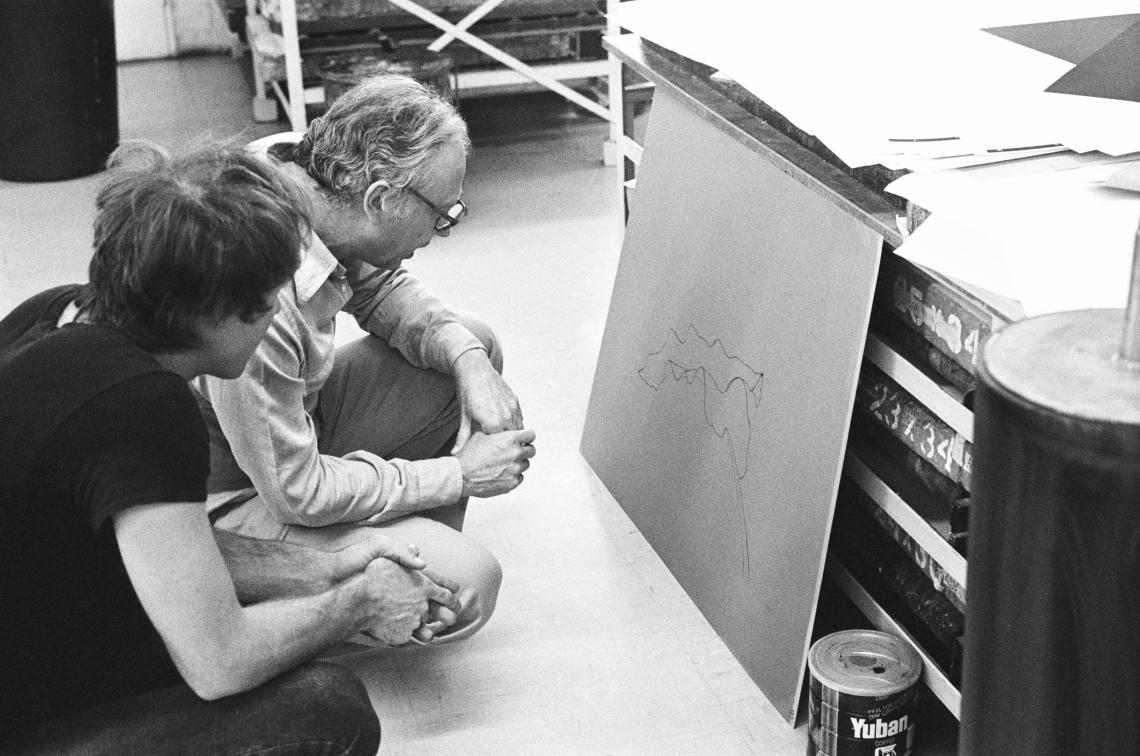
Ellsworth with masterprinter Mark Stock, looking at a Twelve Leaves litho plate, 1978
It is an over-simplification to say that Ellsworth Kelly spent every moment of his day fully engaged in observation. He was a master of taking a shape, like a sly pickpocket, from his observations of natural and man-made objects. But he was not merely a reductive abstractionist; this process informed and inspired his creativity, not dominated it. The studio doors were almost always closed—visitors were rarely present when he was making his art—but his deliberations (at least in printmaking) were exposed to his friends and printmaking collaborators. So I “watched” Ellsworth create forms and observed the marriage of those forms with the perfectly suitable color. I saw how something apparently so simple could be so incredibly precise and challenging; how something we may have seen together or we may have casually discussed entered his studio and made its way onto the litho plate. How a bald head (mine) pressed against a shirtless chest (Ellsworth’s) became a Kelly sculptural relief. How calla lilies brought to the studio by a friend were transformed into a series of lithographic leaves, each with its own distinct personality. Sidney often tells the story of how he observed Ellsworth in the Gemini artist studio, staring intently at a wall of yellow prints, all the same form but each with the slightest variation of color. Ellsworth stood there, motionless, for at least ten minutes, then finally walked away. Puzzled, Sidney said, “Ellsworth, what was that all about?” Ellsworth responded, “There’s a thousand yellows, and I have to be sure I got the right one.”
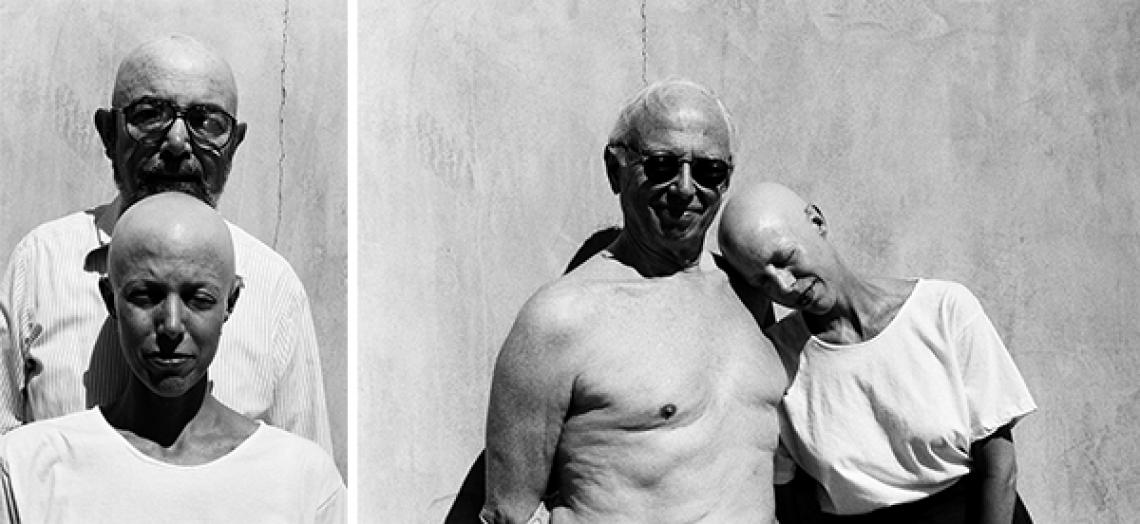
Sidney and Joni, Ellsworth and Joni, in the Gemini parking lot, Summer 1995
With each of the many print series I’ve seen created at Gemini, and by studying the ones I’ve come to know from the past, I’ve learned about Kelly’s art by observing the choices he made in their creation. How the slightest change in the color, the shape, the scale, or the location of the shape on the paper gave birth to a masterpiece. I witnessed his continuous need to challenge—himself and his audience—by making what seemed like modest changes to familiar images, and yet, in doing so, he was working at the very core of his aesthetic. He kept his public on its toes with his use of multiple motifs (plants, portraits, abstraction). The risks he took in printmaking could be subtle and simple (perhaps most notable in his Romanesque Series of 1976) or boldly visible (the introduction of brushstrokes to his prints in 1984 and his dramatic Rivers project of 2004-2005); all are absolutely breathtaking.
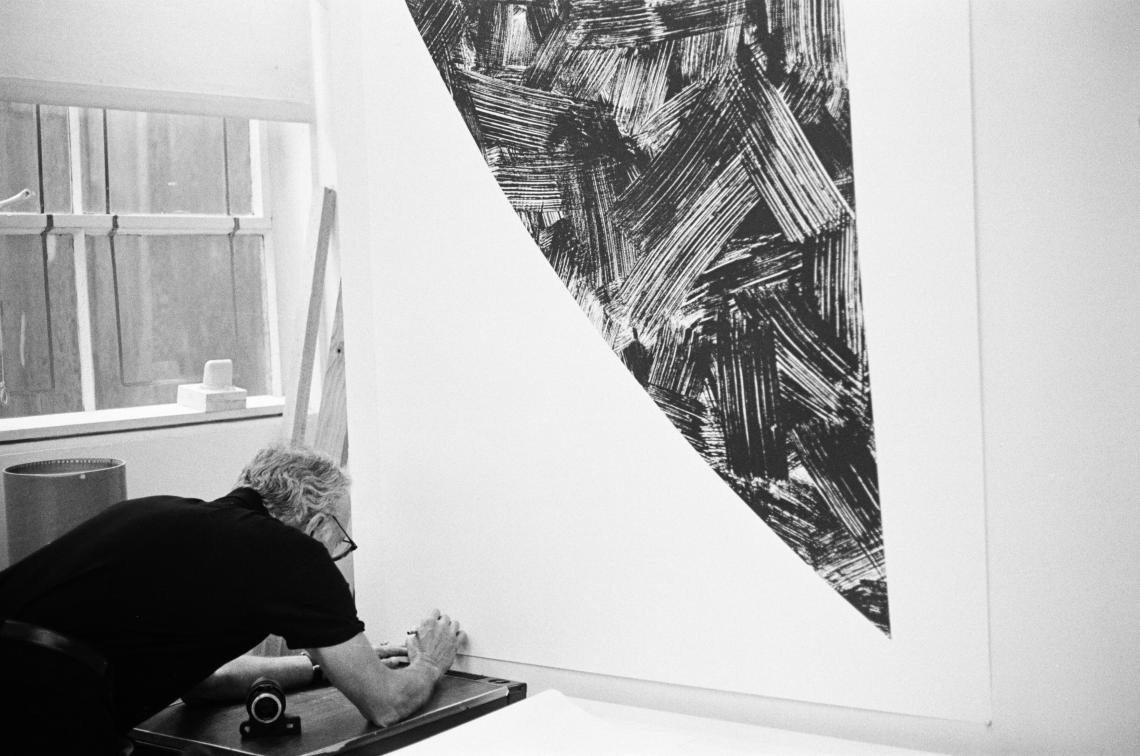
Ellsworth signing the RTP (Right to Print) for Cupecoy, 1984
It would be a nice story to say that I fell in love with Sidney the moment I met him. Or that I instantly loved Ellsworth Kelly’s work on that warm day in August 1977 in Sidney’s office. But neither is true. Sidney’s and my personal and professional lives intertwined and nine years later, on an equally warm late-November day, I married the love of my life. And the Large Gray Curve now hangs in our home like a ketubah. My relationship with Ellsworth’s art progressed similarly. I do marvel at anyone who can see Ellsworth’s art for the very first time and enthusiastically embrace it. For me, it was a curve, a learning curve. A Large Gray Curve. Ellsworth’s work can confound, it can challenge, but ultimately it can make one’s heart and soul soar.

Ellsworth and the love of his life, Jack Shear, to whom he was introduced by Sidney
Letters to Ellsworth focused on Joni’s affectionate relationship with Ellsworth, but on the occasion of his birthday, there are so many people that will be thinking of him today that no story is complete without a mention of others whose lives intersected with Ellsworth. It is impossible to feature them all – here are but just a few:
Ellsworth always had an eye for the Gemini ladies – he was playful, flirtatious, and charming.

With Rosamund Felsen and Elyse Grinstein, co-founders of Gemini G.E.L
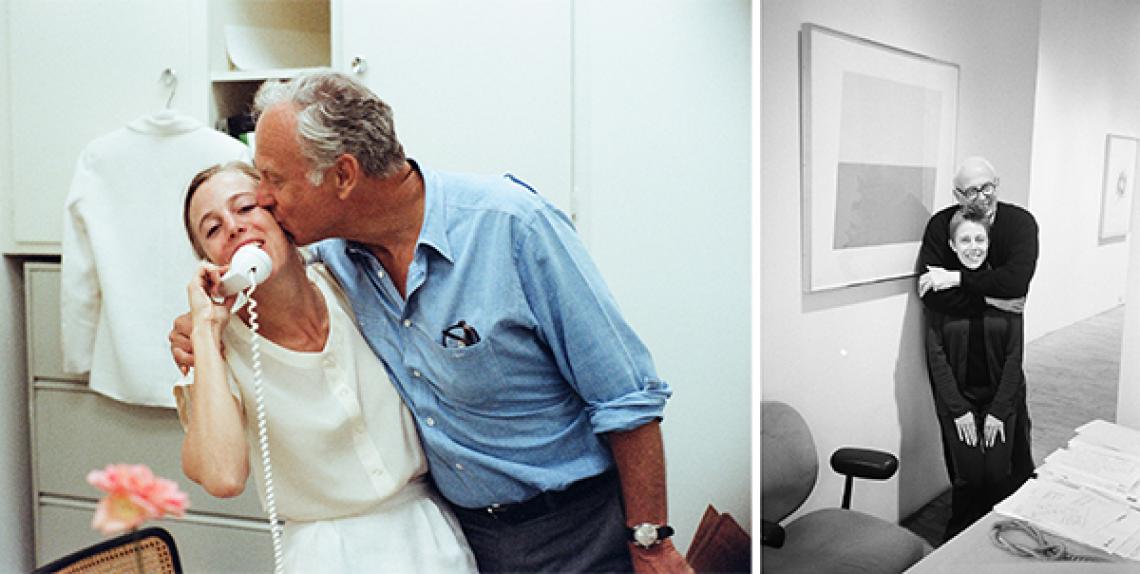
At Gemini, late 1970’s In our West Broadway gallery, 1998
As serious and restrained as his artmaking was, Ellsworth was one of Sidney’s very best subjects, always hamming it up in front of the camera. With affection for Sidney’s hats, the donning of a hat often became just the prop to get Ellsworth started.

Sidney and Ellsworth in front of Mr. Chow’s London, after a day of hat shopping, June 1997
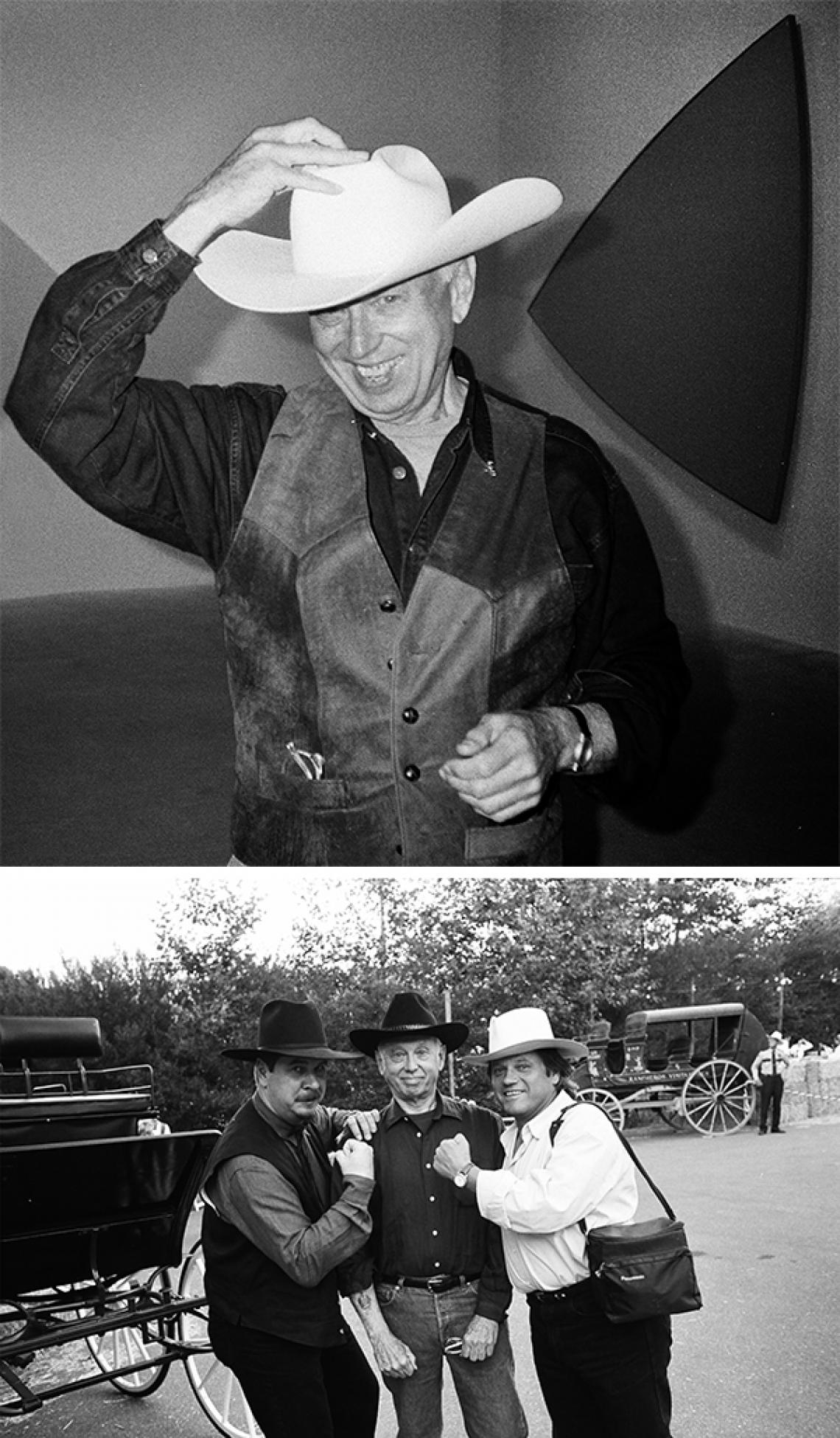
Douglas Cramer’s annual hoedown, with Jack, and Wolfgang Puck, 1996

Ellsworth and David Hockney, on the occasion of Sidney’s 77th “look-alike” birthday party, 2001

Ellsworth in one of Sidney’s quilted velvet hats, kept on hand in case fine-dining establishments require that he take off his fedora, 2002
In addition to the many strictly social interactions, Gemini was the locus of collaborations that were vital to Ellsworth's artmaking.

Working on Twelve Leaves, 1978, with Gemini masterprinter, Serge Lozingot, who was Ellsworth’s primary collaborator from the late 1970s until the early 1980s.
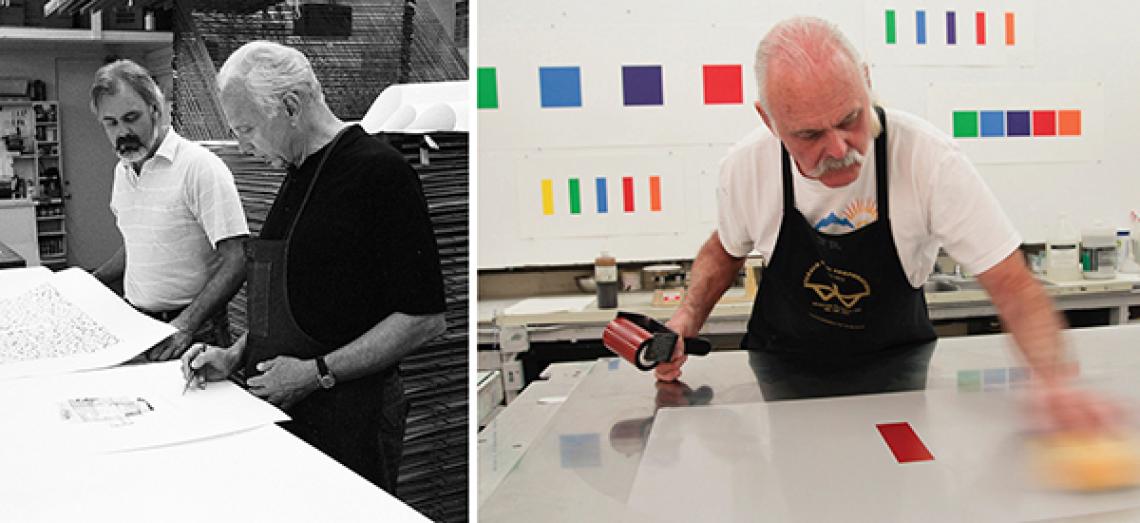
Gemini masterprinter James Reid – reviewing proofs (1990) and printing Color Panels (2011). Following Serge’s retirement, Jim collaborated with Ellsworth for thirty years.

Ellsworth signing St. Martin’s Tropical Plant, with one of his favorite Gemini curators, Bill Padien (November 25, 1981)
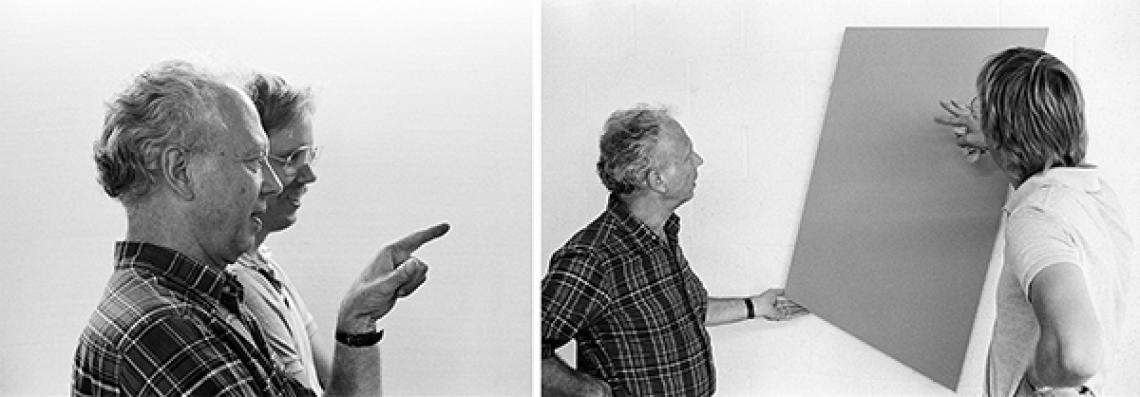
With Peter Carlson, Ellsworth’s fabricator of sculptures large and small, working on the Gemini project, Painted Wall Sculptures, 1982

At the National Gallery of Art, with the author of his print catalogue raisonné and lifelong friend, Rick Axsom, 1992
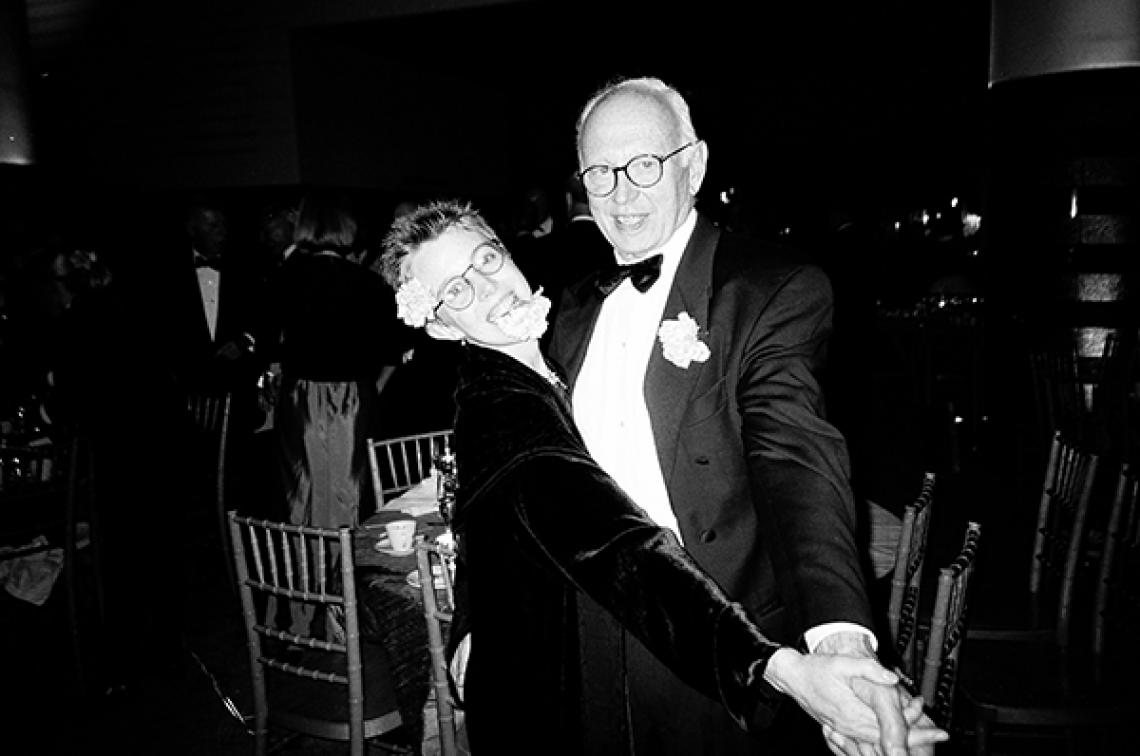
Frolicking at SFMOMA’s celebration of The Anderson Collection, 2000
Happy Birthday, Ellsworth! We're all thinking of you today.


